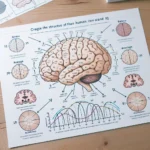Understanding the Relationship Between the Brain’s Structure and IQ
The relationship between the brain’s structure and intelligence quotient (IQ) is a subject of immense intrigue and constant research within the neuroscience and psychology communities. This relationship is like a complex puzzle wherein each piece—the brain’s anatomy—could potentially influence cognitive abilities measured by IQ tests.
IQ is an index of cognitive abilities, such as logical reasoning, problem-solving, mathematical skills, understanding analogies, and vocabulary. It is a standardized score designed to predict an individual’s academic and professional success. However, it goes beyond just answering questionnaires; it reflects a complex interplay of genetic make-up, environmental influences, and the neurobiological infrastructure of the brain.
The brain is an intricate organ, with billions of neurons working synchronously to enable every thought, decision, and emotion. Key structures within the brain, such as the gray matter, white matter, and neural pathways, are thought to play significant roles in cognitive functions.
Gray matter, which contains most of the brain’s neuronal cell bodies, has been a primary focus in studies linking brain structure to IQ. The density and volume of gray matter in various regions of the brain, such as the prefrontal cortex (which is responsible for executive functions like decision-making, complex thinking, and problem-solving), have demonstrated correlations with an individual’s IQ level.
The white matter of the brain, composed of myelinated nerve fibers, is responsible for communication between different brain regions. The integrity of white matter tracts is crucial for efficient signaling and information processing. Studies have shown that better connectivity and white matter quality can be associated with higher IQ scores, indicating that not only the quantity but also the quality of neural connections is vital for intelligence.
The brain’s neural pathways, which transmit signals from one area of the brain to another, also contribute to intellectual capability. Efficient neural networks reduce the need for extensive energy expenditure during cognitive tasks, potentially leading to better performance on IQ tests.
Moreover, the size and functional connectivity of specific brain regions are often analyzed in relation to IQ. For instance, the cerebellum, traditionally associated with motor control, has been recognized for its role in cognitive processes as well, and thus linked to intellectual functioning. The hippocampus, paramount in memory formation, also interacts with IQ as it facilitates the consolidation of information.
Despite these findings, it is important to recognize that intelligence is not determined by brain structure alone. IQ is influenced by a myriad of factors, including educational experiences, cultural background, emotional intelligence, creativity, sensory input, and neuroplasticity—the brain’s ability to adapt and rewire itself throughout life.
As we delve further into the intricacies of the brain, we come to understand that IQ is a multifaceted construct and that the brain’s structure provides a fundamental, yet not exhaustive, map of our cognitive potential. Ongoing research aims to strengthen the understanding of this relationship, which could pave the way for personalized educational strategies and interventions to maximize individual cognitive abilities.
In conclusion, the structure of the brain holds profound links to IQ, underscoring the role of biological substrates in cognitive functions. While we continue to unravel the complexities of the human brain, it’s clear that intelligence is a shared result of both our neuroanatomy and the experiences that shape our neural networks over time. Therefore, while structural aspects of the brain give us valuable insights, they are a part of a larger picture of what intelligence entails.

